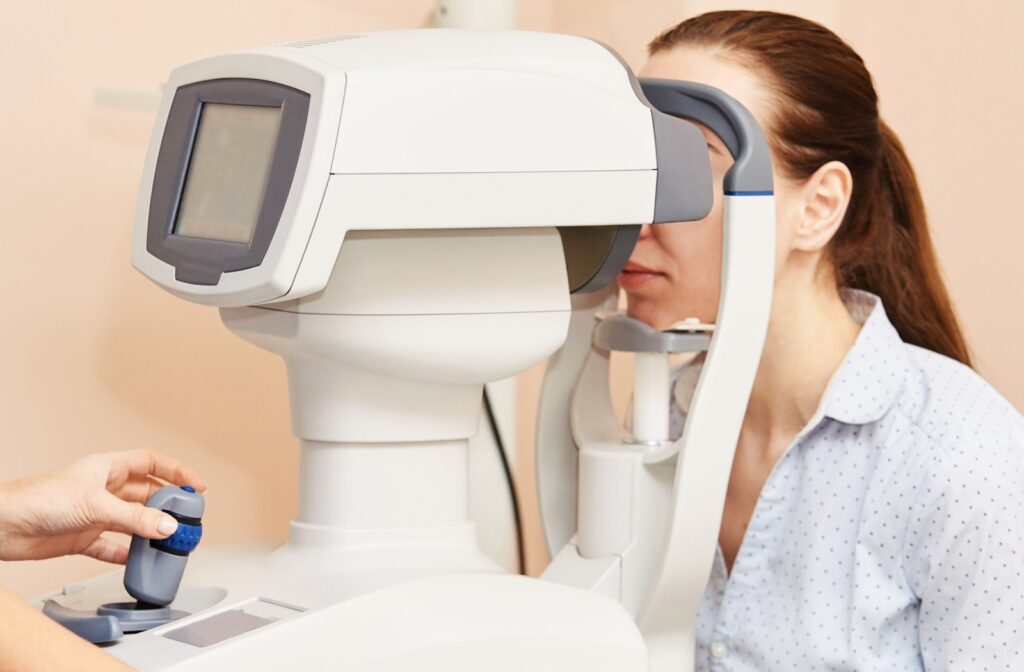Our eyes show a glimpse of our overall health, and with today’s technological advancements, detecting eye and general health conditions early is easier than ever.
OCT scans are helpful tools that allow optometrists to detect abnormal changes to the retina, including the macula, optic nerve, and blood vessels. By monitoring changes in these structures, your optometrist can determine the efficacy of ongoing treatments.
These scans can detect the slightest changes, helping your optometrist diagnose several eye conditions, even in their early stages. These include:
- Age-related macular degeneration
- Diabetic retinopathy
- Glaucoma
- Retinal detachments or tears
What Is an OCT Scan?
OCT stands for optical coherence tomography and is an imaging technique widely used in eye care.
Think of OCT scans as an ultrasound for your eyes. Instead of sound waves, light waves are used to create detailed, layered, and cross-sectional images of the retina, the light-sensitive tissue at the back of your eye.
These scans provide your optometrist with a clear, 3D view of various layers in your retina, allowing them to detect even the smallest changes in tissue or abnormalities.
It’s a non-invasive, quick, and gentle procedure that’s become invaluable in detecting eye conditions and monitoring their progression.
OCT scans are typically used for:
- Detecting early signs of eye conditions, even before symptoms develop.
- Checking for any abnormal changes to the eye during emergency eye visits or diabetic eye exams.
- Monitoring the progress of existing eye conditions like glaucoma, or macular degeneration.
- Assessing overall ocular health during routine eye exams, especially if there’s a family history of eye disease.
OCT Scans vs. Retinal Images
Like OCT scans, retinal images are powerful tools that show a glimpse of ocular health. While both techniques are commonly used in optometry, they serve slightly different purposes.
Retinal images focus on the big picture by capturing a clear image of the retinal surface. They’re ideal for detecting concerns like diabetic retinopathy, macular degeneration, and retinal tears.
Meanwhile, OCT scans zoom into the finer details by providing deeper insight into retinal health. The cross-sectional images of retinal layers show details that can’t be seen on the surface, making these scans useful for detecting abnormal changes before symptoms develop.
With that being said, OCT scans and retinal images complement each other to paint a comprehensive picture of overall ocular health.
What Eye Conditions Can Be Detected with OCT Scans?
OCT scans are a powerful diagnostic tool that can detect a wide range of eye conditions and provide insights into general health conditions.
By analyzing detailed images of the eye, OCT scans can reveal subtle abnormalities and physical signs of various conditions.
Age-Related Macular Degeneration (AMD)
AMD is an eye condition commonly affecting people over 50. It impacts the macula, the central part of the retina responsible for sharp, detailed vision.
Since the macula is within the retina, OCT scans can detect its structural changes. Early signs of AMD visible in these scans include the presence of drusen, which are yellow deposits under the retina.
Additionally, these detailed scans allow your optometrist to differentiate between the “dry” and “wet” forms of AMD, which require different treatments.

Diabetic Retinopathy
Diabetic retinopathy is a complication of unmanaged diabetes, where persistently high blood sugar levels damage blood vessels in the retina, leading to vision loss.
An OCT scan can detect signs of this damage, like retinal swelling, fluid build-up, or abnormal blood vessels, allowing for timely intervention to prevent severe concerns like vision loss.
Glaucoma
Often called the “silent thief of sight,” glaucoma is a group of eye conditions that damage the optic nerve.
Glaucoma develops quietly. Many patients may be unaware they have this condition until it progresses and symptoms like tunnel vision, eye pain, and double vision develop. The quiet onset of glaucoma highlights the importance of routine monitoring.
Major risk factors include:
- Age over 60
- High IOP (intraocular pressure)
- A family history of glaucoma
- Myopia
With an OCT scan, your optometrist can monitor the thickness of the retinal fiber layer and changes in the optic nerve. Thinning of this layer and changes in the optic nerve head are often early indicators of glaucoma, even before noticeable symptoms occur.
Retinal Detachment or Tears
These are considered ocular emergencies and occur when the retina detaches or tears from the back of the eye, potentially leading to permanent vision loss.
When patients complain of seeing new flashes, floaters, and even headaches, optometrists may suspect retinal damage.
Detailed imagery of retinal layers can show even subtle areas of retinal separation, identifying tears or detachment before they worsen and allowing for timely intervention.
Schedule an Appointment & Protect Your Vision
OCT scans are valuable tools in eye care. They can detect the onset of eye conditions and track their progression to determine the efficacy of treatment.
If you’ve never had an OCT scan or it’s been a while, connect with our team at Lowy & Sewell Eye Care to schedule an appointment for your routine eye exam.



